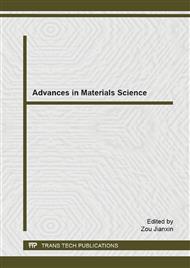[1]
K. WANG. The use of titanium for medical applications in the USA. Materials Science and Engineering A, 213(1-2) (1996) 134-137.
Google Scholar
[2]
C. JOHANSSON, J. LAUSMAA, M. ASK, H. -. HANSSON and T. ALBREKTSSON. Ultrastructural differences of the interface zone between bone and Ti 6Al 4V or commercially pure titanium. Journal of Biomedical Engineering, 11(1) (1989) 3-8.
DOI: 10.1016/0141-5425(89)90158-1
Google Scholar
[3]
M.T. CARAYON and J.L. LACOUT. Study of the Ca/P atomic ratio of the amorphous phase in plasma-sprayed hydroxyapatite coatings. Journal of Solid State Chemistry, 172(2) (2003) 339-350.
DOI: 10.1016/s0022-4596(02)00085-3
Google Scholar
[4]
V. SERGO, O. SBAIZERO and D.R. CLARKE. Mechanical and chemical consequences of the residual stresses in plasma sprayed hydroxyapatite coatings. Biomaterials, 18(6) (1997) 477-482.
DOI: 10.1016/s0142-9612(96)00147-0
Google Scholar
[5]
H. CAULIER, S. VERCAIGNE, I. NAERT, J.P.C.M. VAN DER WAERDEN, J.G.C. WOLKE, W. KALK and J.A. JANSEN. The effect of Ca-P plasma-sprayed coatings on the initial bone healing of oral implants: An experimental study in the goat. Journal of Biomedical Materials Research, 34(1) (1997).
DOI: 10.1002/(sici)1097-4636(199701)34:1<121::aid-jbm16>3.0.co;2-n
Google Scholar
[6]
F. GRIZON, E. AGUADO, G. HURÉ, M.F. BASLÉ and D. CHAPPARD. Enhanced bone integration of implants with increased surface roughness: A long term study in the sheep. Journal of dentistry, 30(5-6) ( 2002) 195-203.
DOI: 10.1016/s0300-5712(02)00018-0
Google Scholar
[7]
L. GUO and H. LI ,. Fabrication and characterization of thin nano-hydroxyapatite coatings on titanium. Surface and Coatings Technology, 185(2-3) (2004) 268-274.
DOI: 10.1016/j.surfcoat.2004.01.013
Google Scholar
[8]
G. -. YANG, F. -. HE, J. -. HU, X. - WANG and S. ZHAO. Effects of biomimetically and electrochemically deposited nano-hydroxyapatite coatings on osseointegration of porous titanium implants. Oral Surgery, Oral Medicine, Oral Pathology, Oral Radiology and Endodontology, 107(6) (2009).
DOI: 10.1016/j.tripleo.2008.12.023
Google Scholar
[9]
J. Rodríquez-Carvajal and T. Roisnel. Line Broadening Analysis Using FullProf*: Determination of Microstructural Properties, Materials Science Forum, 123 (2004) 443-444.
DOI: 10.4028/www.scientific.net/msf.443-444.123
Google Scholar
[10]
H. - R. WENK, L. CONT, Y. XIE, L. LUTTEROTTI, L. RATSCHBACHER and J. RICHARDSON. Rietveld texture analysis of Dabie Shan eclogite from TOF neutron diffraction spectra. Journal of Applied Crystallography, 34(4) (2001) 442-453.
DOI: 10.1107/s0021889801005635
Google Scholar
[11]
G. Ischia, H. -R. Wenk, L. Lutterotti, and F. Berberich. Quantitative Rietveld texture analysis from single synchrotron diffraction images Journal of Applied Crystallography, 38(2) (2005) 377-380.
DOI: 10.1107/s0021889805006059
Google Scholar
[12]
J.M.S. SKAKLE, and R.M. ASPDEN. Neutron diffraction studies of collagen in human cancellous bone. Journal of Applied Crystallography. 35(4) (2002) 506-508.
DOI: 10.1107/s002188980200972x
Google Scholar
[13]
S. Matthies, H. -R. Wenk and G. W. Vinel: Some basic concepts of texture analysis and comparison of three methods to calculate orientation distributions from pole figures Journal of Applied Crystallography. 21 (1988) 285-304.
DOI: 10.1107/s0021889888000275
Google Scholar
[14]
A. BENMAROUANE, T. HANSEN and A. LODINI. Heat treatment of bovine bone preceding spatially resolved texture investigation by neutron diffraction. Physica B: Condensed Matter. 350 (2004) e611-e614.
DOI: 10.1016/j.physb.2004.03.163
Google Scholar
[15]
A. BENMAROUANE, T. HANSEN, P. MILLET and A. LODINI. Texture measurements of hydroxyapatite crystallites at bone-implant interfaces in sheep tibia, Solid State Phenomena. 105 (2005) 427-431.
DOI: 10.4028/www.scientific.net/ssp.105.427
Google Scholar
[16]
A. BENMAROUANE, T. HANSEN, P. MILLET and A. LODINI, 2006. Mechanical properties of hydroxyapatite in bone at the interface with implants. Materials Science Forum. 524 (2006) 951-956.
DOI: 10.4028/www.scientific.net/msf.524-525.951
Google Scholar


